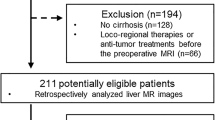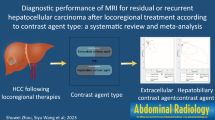Abstract
Purpose
To evaluate the impact of contrast agent selection on radiologists’ confidence in assessing liver lesions on follow-up magnetic resonance imaging (MRI) studies in patients with neuroendocrine tumors.
Methods
This Institutional Review Board-approved, retrospective study performed at a tertiary cancer center and a quaternary care urban academic hospital included all 694 follow-up abdominal MRI studies from 179 patients with gastroenteropancreatic neuroendocrine tumor performed from 01/01/2010 to 05/31/2015. Primary outcome measure was radiologists’ confidence in assessing liver lesions on follow-up MRI. MRI reports were reviewed to abstract radiologists’ confidence, classified as “equivocal” if any equivocal connotation (mention of limitation due to differences in contrast agent or follow-up recommendation with specific contrast agent) was present; or “unequivocal” if a precise, confident comparison to prior was documented without the use of ambiguous terms. A fellowship-trained radiologist separately evaluated 100 randomly selected reports and images to calculate interobserver agreement with the report classification (equivocal vs. unequivocal) and with the original MRI report, respectively. Chi-square test was used to compare the proportion of equivocal reports when “same” or “different” contrast agent was used for successive examinations.
Results
Rates of equivocal reports were higher when different contrast agents were used for successive examinations compared to examinations with same contrast agent (13.2% [21/159] vs. 1.8% [10/535]; p < 0.0001). There was very good interobserver agreement for assessment of radiologist confidence (κ = 0.92 for report review, κ = 0.82 for image review).
Conclusions
Consistent use of contrast agent for follow-up MRIs allows more confident assessment of liver lesions in patients with neuroendocrine tumors.



Similar content being viewed by others
References
Farley HA, Pommier RF (2016) Treatment of neuroendocrine liver metastases. Surg Oncol Clin N Am 25:217–225. doi:10.1016/j.soc.2015.08.010
Geramizadeh B, Kashkooe A, Malekhosseini SA (2016) Liver metastasis of gastrointestinal neuroendocrine tumors: a single center experience. Hepat Mon 16:e37293. doi:10.5812/hepatmon.37293
Kunz PL, Reidy-Lagunes D, Anthony LB, et al. (2013) Consensus guidelines for the management and treatment of neuroendocrine tumors. Pancreas 42:557–577. doi:10.1097/MPA.0b013e31828e34a4
ACR Appropriateness Criteria® suspected liver metastases. | National Guideline Clearinghouse n.d. https://www.guideline.gov/summaries/summary/32614?. Accessed July 17, 2016
Eisenhauer EA, Therasse P, Bogaerts J, et al. (2009) New response evaluation criteria in solid tumours: revised RECIST guideline (version 1.1). Eur J Cancer Oxf Engl 2009;45:228–47. doi:10.1016/j.ejca.2008.10.026
Karademir I, Ward E, Peng Y, et al. (2016) Measurements of hepatic metastasis on MR imaging: assessment of interobserver and intersequence variability. Acad Radiol 23:132–143. doi:10.1016/j.acra.2015.09.002
Botea F, Marconi M, Lutman F, et al. (2010) Radiological estimation of size in colorectal liver metastases: is it reliable? Comparison with post-resectional measurements. Updat Surg 62:21–26. doi:10.1007/s13304-010-0004-0
Neri E, Bali MA, Ba-Ssalamah A, et al. (2016) ESGAR consensus statement on liver MR imaging and clinical use of liver-specific contrast agents. Eur Radiol 26:921–931. doi:10.1007/s00330-015-3900-3
Guglielmo FF, Mitchell DG, Gupta S (2014) Gadolinium contrast agent selection and optimal use for body MR imaging. Radiol Clin North Am 52:637–656. doi:10.1016/j.rcl.2014.02.004
Practical Statistics for Medical Research. CRC Press 1990. https://www.crcpress.com/Practical-Statistics-for-Medical-Research/Altman/p/book/9780412276309. Accessed August 6, 2016
Van Beers BE, Pastor CM, Hussain HK (2012) Primovist, Eovist: what to expect? J Hepatol 57:421–429. doi:10.1016/j.jhep.2012.01.031
Davenport MS, Viglianti BL, Al-Hawary MM, et al. (2013) Comparison of acute transient dyspnea after intravenous administration of gadoxetate disodium and gadobenate dimeglumine: effect on arterial phase image quality. Radiology 266:452–461. doi:10.1148/radiol.12120826
Karaosmanoglu AD, Onur MR, Ozmen MN, Akata D, Karcaaltincaba M (2016) Magnetic resonance imaging of liver metastasis. Semin Ultrasound CT MR 37:533–548. doi:10.1053/j.sult.2016.08.005
Luersen GF, Wei W, Tamm EP, Bhosale PR, Szklaruk J (2016) Evaluation of magnetic resonance (MR) biomarkers for assessment of response with response evaluation criteria in solid tumors: comparison of the measurements of neuroendocrine tumor liver metastases (NETLM) with various MR sequences and at multiple phases of contrast administration. J Comput Assist Tomogr 40:717–722. doi:10.1097/RCT.0000000000000425
Author information
Authors and Affiliations
Corresponding author
Ethics declarations
Funding
None.
Conflict of interest
None.
Ethical approval
All procedures performed in studies involving human participants were in accordance with the ethical standards of the institutional and/or national research committee and with the 1964 Helsinki declaration and its later amendments or comparable ethical standards.
Informed consent
The requirement for informed consent was waived for this IRB-approved retrospective study.
Rights and permissions
About this article
Cite this article
Balthazar, P., Shinagare, A.B., Tirumani, S.H. et al. Gastroenteropancreatic neuroendocrine tumors: impact of consistent contrast agent selection on radiologists’ confidence in hepatic lesion assessment on restaging MRIs. Abdom Radiol 43, 1386–1392 (2018). https://doi.org/10.1007/s00261-017-1302-5
Published:
Issue Date:
DOI: https://doi.org/10.1007/s00261-017-1302-5




